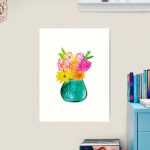Introduction to Cura Vase Mode
Cura Vase Mode is a unique printing feature in the popular slicing software, Cura. This mode is specifically designed for users looking to create aesthetically pleasing objects with a single wall thickness, ideal for vases and other decorative items.
One of the key aspects of the Cura Vase Mode is its ability to produce continuous prints without any internal supports. This results in smoother and more elegant objects, making it a favored choice among hobbyists and professionals alike.
When activating the Cura Vase Mode, the slicer automatically adjusts the print settings to ensure that the extruder’s path creates a seamless outer shell. This is particularly advantageous for artistic designs, where the appearance of layers or internal plumbing could detract from the final product.
The Benefits of Using Cura Vase Mode for 3D Printing

Material Efficiency and Cost-Effectiveness
One of the most appealing aspects of using Vase Mode is its ability to conserve materials. Traditional 3D printing often involves solid infill, which can lead to higher filament consumption and increased costs. In contrast, the Vase Mode allows for a single-layer wall print, which significantly decreases the amount of filament required. This efficiency is particularly beneficial for those who frequently print decorative items that do not require solid interiors. By employing this mode, users can save on filament costs and reduce waste, all while still achieving high-quality designs. Additionally, the reduced material usage makes it an environmentally friendly option for sustainable 3D printing.
Enhancing Design Versatility
Cura Vase Mode opens up a world of design possibilities that can be tailored to various artistic visions. This mode allows for the creation of complex shapes and forms without the constraints typically associated with traditional printing methods. Users can experiment with various design elements, such as twists, curves, and organic shapes, resulting in unique pieces that stand out. The software generates continuous curves rather than distinct layers, leading to smoother finishes and more visually appealing results. This design versatility empowers creators, enabling them to test their artistic limits while using Cura Vase Mode to bring their ideas to life.
Streamlining the Printing Process
One of the significant advantages of using Cura Vase Mode is its simplified printing process. By removing the need for supports and infill, the mode allows users to streamline their workflow. Less setup time means that users can focus on what matters most: creating and experimenting with their designs. Furthermore, the mode is an excellent choice for those who are new to 3D printing, as it limits the complexity that often comes with more advanced settings. As a result, users can achieve successful prints with little prior experience, making Cura Vase Mode ideal for beginners eager to explore the world of 3D printing.
Exploring Unique Textures and Finishes
The printing process in Cura Vase Mode allows for the incorporation of unique textures and finishes in the final product. The ability to control various settings such as layer height, print speed, and temperature results in visually striking pieces. For example, adjusting these parameters can create varying surface textures, from smooth finishes to ribbed looks. This flexibility not only enhances the aesthetic appeal of the printed object but also allows designers to experiment with tactile elements that can increase the visual interest of their creations. Moreover, the translucent effects achieved through careful manipulation of the printing settings can elevate the design, adding depth and dimension to simple forms.
Conclusion
In conclusion, Cura Vase Mode presents a variety of advantages that make it an essential tool in the arsenal of any 3D printing enthusiast. From material efficiency and cost-effectiveness to design versatility and streamlined workflows, this feature simplifies the creative process while enhancing the quality of the final product. For anyone looking to dive into the captivating world of 3D printing, exploring the capabilities offered by Cura Vase Mode is an excellent starting point. It not only allows for stunning designs but also fosters a sense of achievement in creating unique pieces that are both functional and aesthetically pleasing.
Settings and Adjustments in Cura Vase Mode

Properly setting up Cura Vase Mode involves a few important adjustments. Users can set the layer height according to their project needs, affecting the print’s resolution and finish.
The print speed is also customizable. As the Cura Vase Mode prints continuously in a spiral, users might find that adjusting the speed can either enhance the print’s quality or shorten the print time, depending on the filament used.
Additionally, the option to alter the flow rate may prove beneficial. Fine-tuning the flow can lead to denser or more translucent walls, which can be an important consideration for artistic pieces meant to hold light or fluid.
Moreover, settings related to retractions should also be reviewed. Since the Cura Vase Mode typically minimizes the need for retractions, users may want to experiment with different retraction distances to achieve the best results for their specific filament.
Common Challenges with Cura Vase Mode
Using Vase Mode in Cura can lead to several common challenges for users. Here are some of them:
- Inconsistent Layer Adhesion: Since Vase Mode typically involves printing a single perimeter without any infill, if the layer adhesion is poor, the print can be weak and prone to breaking.
- Overhangs and Warping: The lack of support structures in Vase Mode can make it challenging to print models with significant overhangs. This can lead to drooping or warping during the print.
- Z-Calibration Issues: A miscalibrated Z-offset can cause the nozzle to be too close or too far from the bed, leading to poor first layers, which is particularly crucial in Vase Mode.
- Layer Height Limitations: If the layer height is set too high, the print may lose detail or structural integrity. Conversely, if set too low, it can drastically increase print time without a noticeable improvement in quality.
- Material Selection: Some materials may not perform well in Vase Mode, especially those that are prone to stringing. Finding the right filament for optimal results can be challenging.
Tips for Successful Prints in Cura Vase Mode

For those adventurous enough to explore the Vase Mode, several tips can enhance the printing experience. First, ensure that your first layer adheres well to the build plate. A strong start is often the key to a successful print.
Consider experimenting with different wall thicknesses within the parameters of this mode. While a single wall is standard, adjusting this can affect the print’s stability and appearance.
Utilize supports intelligently. Although the Vase Mode minimizes internal support needs, there are occasions when external support structures may be necessary for larger or more elaborate designs. Reassessing support settings can be beneficial.
Lastly, keep an eye on filament quality. Quality filaments tend to perform better in the Vase Mode, resulting in smoother finishes and more reliable prints. Investing in quality materials can significantly enhance the overall satisfaction with the final product.
Conclusion: The Future of 3D Printing with Cura Vase Mode
As 3D printing technology progresses, features like the Vase Mode remain at the forefront, encouraging creativity and pushing the boundaries of what is possible with this technology. With its focus on minimizing wall thickness and aiming for a perfect finish, it sets a standard for what modern printing can achieve.
Whether users are crafting decorative vases or venturing into more complex designs, understanding how to leverage the capabilities of the Cura Vase Mode can lead to impressive results. The integration of artistic elements with technical precision embodies the spirit of innovation within the 3D printing community.
Moving forward, we can anticipate enhanced functionalities and new materials that further enhance the capabilities of Cura Vase Mode, leading to even more diverse applications and more users embracing this feature confidently.
This article provides valuable insights and tips on using the “Cura Vase Mode,” making it easier for users to navigate this particular printing process effectively.

